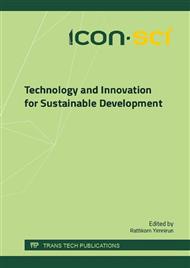[1]
F. Herzog, Z. Farah, R. Amado, Composition and consumption of gathered wild fruits in the V-Baoule, Cote D'Ivoire, Ecol. Food Nutr. 32 (1994) 181–196.
DOI: 10.1080/03670244.1994.9991399
Google Scholar
[2]
I.E. Ezeagu, Nutritional value of tropical plant seeds, Agronomy Monograph 51(2009) 39-53.
Google Scholar
[3]
F. Anwar, S. Latif, M. Ashraf, A.H. Gilani, Moringa oleifera: A food plant with multiple medicinal uses, Phytother. Res. 21 (2007) 17-25.
DOI: 10.1002/ptr.2023
Google Scholar
[4]
A.A.L. Ordonez, J.D. Gomez, M.A. Vattuone, M.I. lsla, Antioxidant activities of Sechium edule (Jacq. ) Swartz extracts, Food Chem. 97 (2006) 452-458.
DOI: 10.1016/j.foodchem.2005.05.024
Google Scholar
[5]
Association of Official Analytical Chemists (AOAC). Official Methods of Analysis of AOAC International, 17th ed., AOAC International, Gaithersburg, MD, USA, (2000).
DOI: 10.1093/9780197610145.003.009
Google Scholar
[6]
Department of Medical Sciences (DMSc) and Department of Medical Sciences Foundation, Compendium of Methods for Food Analysis, National Bureau of Agricultural Commodity and Food Standards (ACFS), first ed., Thailand, (2003).
Google Scholar
[7]
H. Indyk, E. Konings, AOAC official method 942. 23, Thiamine (vitamin B1) in foods, 17th ed., AOAC International, Gaithersburg, MD, USA, 2000, pp.45-46.
Google Scholar
[8]
L.W. Randy, L.W. David, Simultaneous determination of pyridoxine, riboflavin, and thiamin in fortified cereal products by high-performance liquid chromatography, J. Agric. Food Chem. 32 (1984) 1326–1331.
DOI: 10.1021/jf00126a027
Google Scholar
[9]
K. Ghasemi, Y. Ghasemi, M.A. Ebrahimzadeh, Antioxidant activity, phenol and flavonoid contents of 13 Citrus species peels and tissues, Pak. J. Pharm. Sci. 22 (2009) 277-281.
Google Scholar
[10]
M.A. Ebrahimzadeh, S.J. Hosseinimehr, A. Hamidinia, M. Jafari, Antioxidant and free radical scavenging activity of Feijoa sallowiana fruits peel and leaves, Pharmacologyonline. 1 (2008) 7-14.
Google Scholar
[11]
J.W.H. Yong, L. Ge, Y.F. Ng, S.N. Tan, The Chemical composition and biological properties of coconut (Cocos nucifera L. ) water, Molecules. 14(2009) 5144-5164.
DOI: 10.3390/molecules14125144
Google Scholar
[12]
C.M. Burgess, E.J. Smid, D. Sinderen, Bacterial vitamin B2, B11 and B12 overproduction: An overview, Inter. J. Food Microb. 133 (2009) 1-7.
DOI: 10.1016/j.ijfoodmicro.2009.04.012
Google Scholar
[13]
P. J. Thornalley, The potential role of thiamine (vitamin B1) in diabetic complications, Curr. Diabetes Rev. 1(2005) 287-298.
DOI: 10.2174/157339905774574383
Google Scholar
[14]
C.Y. Wong, J. Qiuwaxi, H. Chen, S.W. Li, H.T. Chan, S. Tam, X.O. Shu, C.P. Lau, Y.L. Kwong, H.F. Tse, Daily intake of thiamine correlates with the circulating level of endothelial progenitor cells and the endothelial function in patients with type II diabetes, Molec. Nutr. Food Res. 52 (2008).
DOI: 10.1002/mnfr.200800056
Google Scholar
[15]
N. Wu, K. Fu, Y.J. Fu , Y.G. Zu , F.R. Chang, Y.H. Chen, X.L. Liu, Y. Kong, W. Liu, C.B. Gu, Antioxidant activities of extracts and main components of Pigeonpea [Cajanus cajan (L. ) Millsp. ] leaves, Molecules. 14 (2009) 1032-1043.
DOI: 10.3390/molecules14031032
Google Scholar
[16]
D. E. Pratt., Natural Antioxidants from Plant Material, ACS Symposium Series (507), Phenolic Compounds in Food and Their Effects on Health II, ACS Symposium Series, USA, 2009, p.54–71.
DOI: 10.1021/bk-1992-0507.ch005
Google Scholar


